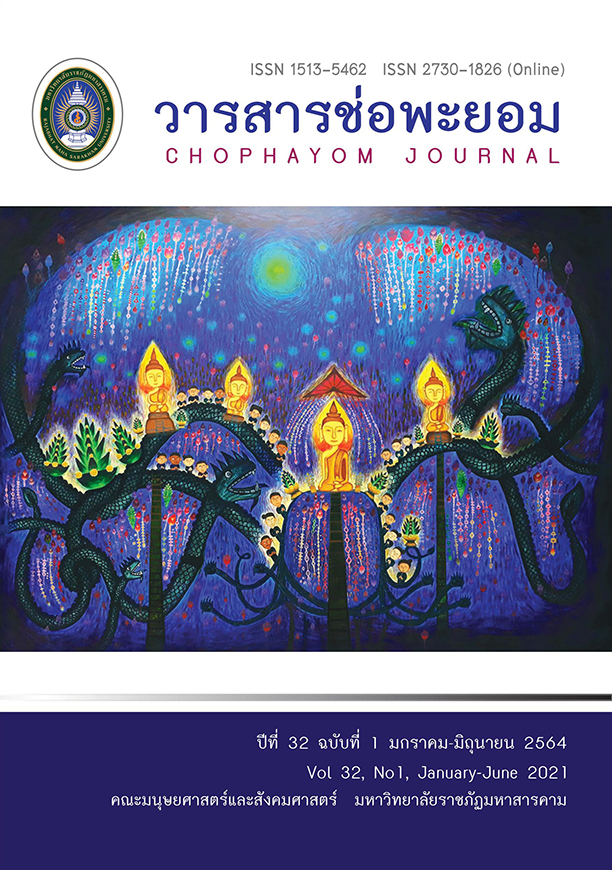Chinese Learning Styles Development through Learning by Doing
Keywords:
Learning Chinese, learning by doingAbstract
The research on the development of Chinese learning model through the process of learning by doing aims to develop Chinese learning model through the process of learning by doing, to study the efficiency of Chinese language skills of learners through learning by doing, and to study the learners’ satisfaction of the learning by doing. The target group used to determine Chinese learning model through learning by doing consisted of 12 instructors and a group of Chinese language experts in higher education level and 75 students who were trained Chinese language from travel retail businesses in the academic year of 2019. Data collected were analyzed by Typological Analysis, Taxonomy Analysis, Statistical Methods and using the dependent sample t-test as statistics. The results revealed that 1) the appropriate form of learning by doing model for creating useful experience and skills in Chinese for students in Chinese language courses should allow all learners to easily learn and understand contents through actual experience whether inside, outside, or from the workplace which will help to build the beneficial skills to work or self-development for students. The integration of Chinese language knowledge with other knowledge could create opportunities for learning with native speakers directly. 2) the student’s achievement after received learning by doing was higher than before receiving learning by doing with statistical significance at the level of .01. 3) all learners were satisfied with learning by doing model at the highest level as overall with the arithmetic means of 4.61. When considered each item, it was found that all items were at the highest level. Keywords: Learning Chinese, learning by doing
References
ฐิติชญาน์ ราชคำสุข. (2561). การเรียนรู้โดยการลงมือทำ (Learning by doing). สืบค้นเมื่อ 18 มีนาคม 2562, จาก https://mcpswis.mcp.ac.th/html_edu/cgi-in/main_php/print_informed.php?id_count_in form=29180
พุ่มพฤกษ์ กำสมุทร. (2551). การประยุกต์ใช้กระบวนการเรียนรู้จากประสบการณ์สาระการเรียนรู้คณิตศาสตร์ เรื่อง การบวก การลบ ชั้นประถมศึกษาปีที่ 4. วารสารมหาวิทยาลัยราชภัฏมหาสารคาม, 2(1), 81 – 90.
ภัทรุท นามเมือง. (2557). การพัฒนาผลสัมฤทธิ์ทางการเรียนรู้วิชาระบบบัญชีเดี่ยวและสินค้าโดยจัดกิจกรรมการสอนแบบ learning by doing ด้วยหลัก 5 ค. (งานวิจัยในชั้นเรียน, วิทยาลัยเทคโนโลยีวานิชบริหารธุรกิจ).
สำนักงานเลขาธิการสภาการศึกษา. (2559). รายงานการวิจัยเพื่อพัฒนาการเรียนการสอนภาษาจีนในประเทศไทย กรณีศึกษามหาวิทยาลัยปักกิ่ง สาธารณรัฐประชาชนจีนในการสอนภาษาจีนให้แก่ชาวต่างชาติ. กรุงเทพฯ: กระทรวงศึกษาธิการ.
สุทัศน์ ภูมิภาค. (2562). Active Learning คืออะไร? สอนยังไงให้เป็น Active Learning?. สืบค้นเมื่อ18 มีนาคม 2562, จาก https://www.kruupdate.com/active-learning-%E0%B8%84%E0%B8%B7%E0%B8%AD%E0%B8%AD%E0%B8% B0%E0%B9%84%E0%B8%A3-%E0%B8%AA%E0%B8%AD%E0%B8%99%E0%B8%A2%E0%B8%B1%E0%B8%87%E0% B9%84%E0%B8%87%E0%B9%83%E0%B8%AB%E0%B9%89%E0%B9%80%E0%B8%9B/
สุภิญญา เรือนแก้ว. (2552). ความสำคัญของภาษาจีนในปัจจุบัน. สืบค้นเมื่อ 18 มีนาคม 2562, จาก http://ning-50010110079.blogspot.com/






